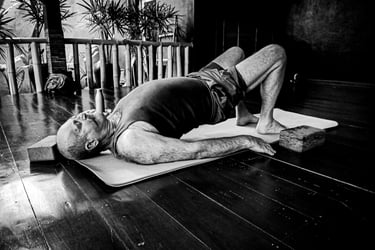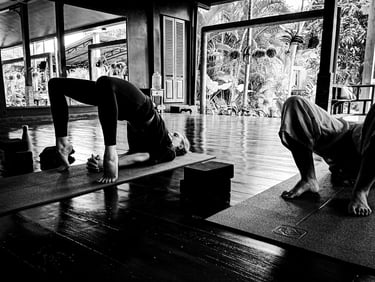Yoga for Flight Attendants
Why the Spine Bears the Brunt
One key contributor to spinal stress is the force needed to push fully stocked meal and beverage trolleys. When aircraft are angled slightly during take-off or taxiing, pushing trolleys “uphill” significantly increases the load on the lower back. Even minor inclines, over time, become meaningful stressors. Add to this the jolts from turbulence and prolonged standing or sitting in cramped crew seats, and the spine—particularly the lumbar region—absorbs a great deal of wear and tear.
The Risk of Herniated Discs
Not surprisingly, reports of lumbar disc herniation are common among cabin crew. The biomechanics involved—axial loading under rotation, repetitive forward bending, and compromised posture—are consistent with known mechanisms for disc injury. Though less frequently, sacral disc herniation can also occur. In my teaching experience, sacral involvement has often stemmed more from individual movement behaviours and postural habits rather than the occupational demands themselves.
The physical demands placed on airline cabin crew are often underestimated. While the role is commonly associated with customer service and safety, the repetitive and forceful physical actions required over the course of a shift—or an entire career—can lead to cumulative strain on the spine.
Cabin crew routinely engage in tasks such as pushing and pulling heavy trolleys, lifting luggage into overhead bins, and working in the narrow, restrictive aisles of an aircraft. These actions often require twisting, bending, and reaching in awkward positions, all while managing balance during in-flight turbulence or while the plane is taxiing, climbing, or descending.
Rehabilitation Through Yoga
Recovery from disc herniation—whether lumbar or sacral—requires a respectful, staged approach. In our classes,we begin with non-weight-bearing, reclining poses that allow the spine to decompress. These foundational postures support gentle breath awareness and core engagement without spinal loading.
One informal but useful indicator of progress is whether a student can bend to tie their shoes without pain—a task that demands flexion, coordination, and confidence in the back. Once this becomes accessible, we introduce simple standing postures that reintroduce load in a controlled manner.
A valuable transitional pose in this journey is Tadasana with a toe reach—a variation that encourages gentle spinal elongation and posterior chain activation while remaining well within a safe range.




The Role of Bridge Pose in Sacral Stability
For those with sacral involvement or instability around the pelvis, we place special emphasis on Bridge Pose (Setu Bandhasana). This pose supports rehabilitation in several ways:
It activates the glutes and hamstrings, key stabilisers for the sacroiliac region.
It helps strengthen deep spinal muscles, such as the multifidus and erector spinae, improving postural control.
When practiced with awareness, it promotes neutral pelvic alignment and discourages over-arching in the lumbar spine.
As a supported, supine pose, Bridge Pose allows for progressive load-bearing without compressing vulnerable spinal structures.
With breath-led movement, it also supports diaphragmatic and pelvic floor coordination, vital for intra-abdominal pressure management and spinal integrity.
Final Thoughts
Cabin crew face a unique combination of repetitive physical strain, restricted movement, and unpredictable environmental stressors. These factors contribute to a higher-than-expected risk of spinal issues—particularly in the lumbar region. Yoga, when applied thoughtfully and progressively, offers an effective, embodied path to recovery.
By beginning with spinal unloading, integrating controlled strength work such as Bridge Pose, and gradually restoring functional movements like forward folds and standing alignment, we not only rehabilitate the spine—we help them regain confidence in their bodies.
More Insights
